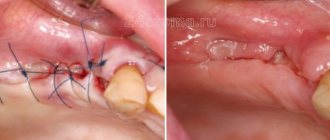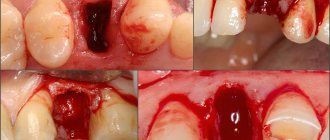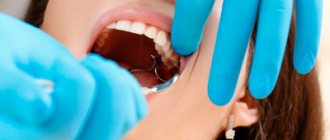Description
Tooth extraction is accompanied by bleeding, which most often stops after a few minutes with the formation of a blood clot. However, in some cases it does not stop on its own and continues for a long time - primary bleeding. Sometimes bleeding appears some time after the operation (several hours or even days later - secondary bleeding. Prolonged bleeding is most often caused by local causes, less often by general ones.
ICD code for alveolar bleeding
After tooth extraction (ICD 10 code: K08.1), the alveoli are naturally filled with a blood clot formed as a result of bleeding from a rupture of the dental artery, the network of arterioles and capillaries of the periodontium and gums. This bleeding is capillary and parenchymal in nature, usually occurs after tooth extraction and stops after a few minutes (from 5 to 20 minutes). The pressure of the gauze pad used to cover the wound helps to stop bleeding more quickly. Rinsing your mouth after tooth extraction prevents bleeding from stopping.
In some cases, bleeding in the area of the extracted tooth socket does not stop or stops and reappears after a few hours or even days. Typically, most bleeding after tooth extraction is caused by local causes: deep rupture and crushing of the gums, the presence of an inflammatory process, paralysis of the vascular walls after the use of adrenaline. Secondary bleeding associated with infection of the socket and disintegration of the blood clot are also observed.
In more rare cases, such bleeding is caused by general causes associated with blood clotting disorders (hemorrhagic diathesis and diseases with hemorrhagic symptoms). In most cases, bleeding after tooth extraction, due to reasons of both local and general nature, can be stopped using the generally accepted method - tamponade of the hole with iodoform gauze. Tamponade of the hole with iodoform gauze to stop bleeding must be done very carefully. To do this, blood clots are removed from the patient’s mouth and the bleeding hole is dried with a gauze swab in order to determine upon examination where the bleeding is coming from - from the alveoli or from the gums.
When bleeding from torn edges of the gums, after applying a hemostatic clamp to the gingival edge, it is enough to sew the gingival edges, trim or bandage the bleeding vessel. If bleeding occurs from the bone septum, then the bleeding area is compressed by squeezing the bone with bayonet-shaped forceps with non-converging cheeks. After this, the hole is tamponed.
ETIOLOGY AND PATHOGENESIS
The cause of bleeding from the tooth socket is tissue trauma, rupture of blood vessels (dental artery, arterioles and capillaries of the periodontium and gums) during operations in the maxillofacial area, most often tooth extraction or trauma. After a few minutes, blood clotting in the hole occurs and bleeding stops. However, some patients experience disruption of clot formation in the socket, which leads to prolonged bleeding. More often this is due to significant damage to the gums, alveoli, oral mucosa, pathological processes in the maxillofacial area (trauma, bacterial inflammation), less often - the presence of concomitant systemic diseases in the patient (hemorrhagic diathesis, acute leukemia, infectious hepatitis, arterial hypertension, diabetes mellitus). diabetes, etc.), taking drugs that affect hemostasis and reduce blood clotting (NSAIDs, antiplatelet agents, anticoagulants, fibrinolytic drugs, oral contraceptives, etc.).
With prolonged bleeding, the patient's condition worsens, weakness, dizziness, pale skin, acrocyanosis, decreased blood pressure and a reflex increase in heart rate appear.
If the patient was administered a local anesthetic drug with epinephrine, which has a vasoconstrictor effect, when its concentration in the tissues decreases, the vessels dilate and stopped bleeding can resume, i.e. Early secondary bleeding may occur. Late secondary bleeding occurs after several hours or days.
Titles
Post-extraction bleeding.
Classification, features of the course of the disease
Pathology is classified into primary and secondary bleeding. The first group is bleeding that developed immediately after tooth extraction, secondary bleeding - after some time. Approximately 65-94% of all cases occur in the secondary group, which is divided into early and secondary late types.
Externally, bleeding is manifested by the following signs:
- the blood from the hole does not stop, it can pulsate;
- feeling unwell;
- pressure is reduced;
- dizziness appears;
- rapid pulse;
- the skin becomes pale in color.
Clinical picture
Symptoms of the pathology are blood leaking out from under the blood clot and spreading to adjacent tissues and teeth. When the arteries or arterioles of the mucous membrane are damaged, the blood flow pulsates.
The long process is accompanied by manifestations of blood loss: deterioration of health, pallor of the skin, acrocinosis, increased heart rate, dizziness and hypotension. The listed signs are life-threatening. When they appear, a doctor's examination is required.
Differential diagnosis
What a doctor should do if a patient complains of alveolar bleeding:
- Clinical examination.
- Measurement of heart rate and blood pressure.
The dentist will certainly conduct a survey of the patient. List of questions:
- General health.
- Time of bleeding.
- Were there any provoking factors present?
- Does the patient suffer from hypertension?
- Have you ever had problems stopping bleeding from cuts and injuries?
- There is an increase in body temperature.
- Measures taken by the patient to eliminate the pathology.
- Presence of concomitant pathologies.
- What medications does the person take?
Hospitalization is required for persons taking medications that reduce blood clotting.
Differential diagnosis is carried out with systemic diseases that have complications in the form of increased bleeding.
Recommendations for the patient
Some patients are able to cope with the pathology on their own. A set of simple measures will help:
- Blood pressure measurement. If the value increases above normal, you must take appropriate medications.
- Make a turunda from cotton wool or gauze and press it tightly to the hole. Pre-treat the area with 3% hydrogen peroxide. After half an hour, release the pressure on the bandage.
- Rinse your mouth. Do not consume hot food or drinks.
- Apply cold to the “sick” cheek.
It is forbidden to “put” cold directly into the hole. This will lead to inflammation and infection.
If the condition worsens, you should consult a dentist or call an ambulance.
Treatment methods
If there are signs of serious blood loss, hospitalization and intensive infusion are required.
- Local therapy
Methods for stopping bleeding using local therapy are determined by the reasons that provoked the pathology. If blood comes from the hole, the area needs to be cleaned of the clot and antiseptic treatment is required. The problem area is dried with a tampon and tamponade is performed with a turunda with iodoform or a hemostatic sponge.
The hole is filled, starting from the bottom, layer by layer. When deleting an element with multiple roots, each channel is processed separately.
Upon completion of packing, the edges of the wound are connected and sutured. The gums are covered with a gauze pad for an hour. If there is no bleeding, the gauze is removed and the patient is sent home.
If bleeding continues, packing is repeated and ice is applied to the cheek. Turunda is removed from the hole after five days.
Gum rupture is repaired by suturing. When perforation of the bony septum occurs, the edges are compressed with orthodontic forceps and tamponade is performed. Occasionally, ligation is required.
- General methods
The method of stopping the flow of blood from the socket due to systemic reasons is determined by their type and nature.
For blood clotting disorders, coagulants are used. For hemorrhages due to hypertension, antihypertensive drugs are used. The doctor selects drug treatment based on clinical indications.
Causes
Local causes of alveolar bleeding: damage (rupture, crushing) of soft tissue and bone vessels during traumatic surgery; fracture of the alveolar wall or interradicular septum; the presence of an intraosseous vascular tumor; during an acute inflammatory process (inflammatory hyperemia), in the second phase of the action of vasostrictors (vasoparesis), during purulent melting of a blood clot and thrombi in the vessels during alveolitis. Common causes of prolonged post-extraction bleeding are due to a violation of the blood clotting process or a violation of the vascular system. These include hemorrhagic diathesis: hemophilia, thrombocytopenic purpura (Werlhof's disease), hemorrhagic vasculitis, hemorrhagic angiomatosis (Rendu-Opeler disease), angiohemophilia (Villebran disease), C-vitaminosis, diseases accompanied by hemorrhagic symptoms: acute leukemia, infectious hepatitis, septic endocarditis, typhus and typhoid fever, scarlet fever and; in patients receiving anticoagulants, in patients suffering from hypertension.
Local factors
- Ruptures or injury to soft tissues. These are the most common causes of alveolar hemorrhages.
- Destruction of a blood clot formed in the socket. This can be caused by the actions of the patient himself, for example, active rinsing of the mouth, and alveolitis that develops as a result of infection of the socket.
- Damage (fracture) of the alveoli or bone septum located between the teeth.
- Opened vascular tumor in the area of the extracted tooth.
- Inflammatory process in periodontal tissues of various etiologies.
This is interesting: The wisdom tooth is growing and the gums hurt - what to do and what to rinse with
High blood pressure
A patient with hypertensive pathology often experiences bleeding from the socket, so if he has such a disease, he should inform the doctor about it before the operation. This will allow you to find an individual approach to a problem patient and prevent possible complications.
Poor blood clotting
If the patient has previously been diagnosed with coagulation disorders, then he is obliged to inform the doctor about the existing problems in order to prevent negative consequences.
Inflammation of the socket
After surgery, the doctor must treat the hole with an antiseptic. But even treatment is not always a guarantee that the bleeding will stop after wisdom teeth are removed. If the socket is a source of infection, the gums usually bleed. In such cases, you should not resort to self-medication, as this can lead to dire consequences. Only a professional specialist can correctly diagnose and prescribe effective treatment.
Purulent accumulations
Before performing any manipulation, the dentist must diagnose the patient’s jaw and make sure there are no pathologies. If there are already purulent accumulations inside the gums, this can provoke heavy bleeding, which is quite difficult to stop.
Damage to the integrity of blood vessels
Due to the irregular growth and location of wisdom teeth in hard-to-reach areas of the oral cavity, the removal of such units is considered a relatively complex dental procedure. Vessels are almost always damaged by surgical instruments. Usually, after several hours, the bleeding stops, but the patient may simply not feel pain due to prolonged exposure to the anesthetic. If large vessels are damaged during surgery, bleeding may occur later and in such cases you should not hesitate to visit the dentist.
Failure to comply with medical recommendations
A rather complex procedure is the removal of a wisdom tooth; bleeding can occur in every patient, even if the operation is performed correctly. The reason for this is improper wound care, which leads to a deterioration in the condition of the hole and the development of an inflammatory process.
General factors
Systemic factors causing alveolar hemorrhage include a group of diseases collectively called hemorrhagic diathesis. Their reasons may be different:
- Deficiency of certain proteins responsible for platelet hemostasis (thrombocytopathy and thrombocytopenia).
- Damage to the walls of blood vessels (Osler syndrome, hemorrhagic vasculitis, hemorrhagic telangiectasia, etc.).
- Bleeding disorders (fibrinolytic purpura, hemophilia, radiation sickness).
- Regular or temporary use by the patient of aspirin-containing drugs , fibrinolytics, anticoagulants.
A tendency to bleeding can also be caused by certain infections (typhoid, scarlet fever), liver pathologies (hepatitis, cirrhosis), diabetes mellitus, and changes in hormonal status.
Increased blood pressure may also be the cause of blood flow from the socket that does not stop. Moreover, this is one of the most common common factors of any hemorrhage, including alveolar hemorrhage.
Statistics and reasons
According to statistics, bleeding after removal of a dental element occurs in 0.25% of patients. The cause of complications in 70% is the condition of the mucous membranes surrounding the hole and other local factors:
- Injuries to soft tissues, alveoli or interradicular septum.
- Termination of the effect of adrenaline as part of anesthesia.
- Inflammation in the damaged area.
- Alveolitis, which provoked purulent melting of a blood clot inside the unit.
- Damage to vessels located close to distant elements.
- Hemangioma.
- Damage to a blood clot in the socket.
The most common factor in the development of pathology is damage to periodontal tissues.
30% of bleeding is caused by systemic disorders in the body:
- Hemorrhagic diathesis.
- Hypertension.
- Diseases of the walls of blood vessels.
- Infectious diseases.
- Menopausal factor and other hormonal imbalances.
- Blood diseases.
How long does bleeding last
Patients are interested in the answer to the question of how long bleeding lasts after tooth extraction.
Normal: from 10 to 30 minutes. It is during this period of time that the first blood clot should normally form, and the blood, accordingly, will clot and gradually stop. This should happen even if a complex procedure was performed, for example, a wisdom tooth was removed.
Pathology: prolonged bleeding after tooth extraction, which can last from several hours to several days. It is also impossible to call situations normal when the blood stopped in the dentist’s office, but at home it began to flow again, and not to ooze, but to be released in large volumes.
Reviews
Continuous bleeding after tooth extraction or its resumption after some time is a signal of trouble in the body or the site of tooth extraction.
Ignoring it means creating a threat to your health. If you have experience dealing with alveolar bleeding, share it with other visitors to our site. Leave your comment at the bottom of the page. It is possible that your advice will be vital for someone.
If you find an error, please select a piece of text and press Ctrl+Enter.
Tags socket bleeding tooth extraction
Did you like the article? stay tuned
No comments yet
Diagnostics
Primary diagnostic methods:
- measurement of pressure level, pulse rate;
- external examination, examination of the oral cavity, tooth extraction sites.
During the examination, the patient will be asked questions about his health and the time of occurrence of complications. It is necessary to determine the cause of the problem, for example, whether the patient has eaten or drunk, or whether there is a fever. In some cases, differential diagnosis will be carried out to determine the presence of the following diseases - diabetes, hypertension, diathesis, hepatitis, leukemia during an exacerbation.
Differential diagnosis
The main goal of diagnosis is to differentiate local factors from systemic factors or the consequences of taking anticoagulant drugs. Questions to the patient help clarify the picture:
- what diseases does he suffer from?
- whether he is taking aspirin-containing drugs, oral contraceptives, NSAIDs and other drugs that cause a decrease in blood clotting;
- Have you had any difficulty stopping bleeding before?
To establish the exact cause of hemorrhage, it is necessary to exclude or confirm diseases that can cause coagulopathy:
- hemorrhagic diathesis;
- hemophilia;
- leukemia;
- liver cirrhosis or hepatitis;
- diabetes.
When differentially diagnosing alveolar bleeding, a blood test is usually required, and there is a need to involve a hematologist.
How to solve the problem at home
What to do if a similar situation arises with you or your immediate family? First of all, you need to assess the scale of the problem and the intensity of the bleeding. If it is really strong and does not go away for a long time, then you cannot hesitate; you cannot do without professional help and you need to visit a dental surgeon. Also, consulting a doctor is simply necessary in situations where the phenomenon was caused by systemic diseases of the body (diabetes mellitus, impaired hemostasis). If blood only oozes, then first aid must be provided. Let's look at local ways to stop bleeding.
Tampon application
Applying a tampon will help stop bleeding
You will need a regular sterile bandage. Make a fairly tight tampon from the bandage, then apply it tightly to the wound surface and bite. Despite the fact that such a homemade tampon should fit very tightly, it should not cause pain. How long does it take for the bleeding to stop in this case? You need to keep the bandage on for about 20-30 minutes; due to compression (squeezing) of the edges of the wound, improvements should occur during this period of time.
If the procedure is not beneficial, you can roll the gauze swab out of the bandage again and pre-moisten it with hydrogen peroxide (3%). Next, you need to repeat the procedure.
Application of cold
You can narrow blood vessels and stop bleeding with ice, as well as any product taken from the freezer. The main conditions here are to apply cold only externally, after wrapping it in a towel or any other soft cloth. Apply to the cheek from the side of the extracted tooth, leave for five minutes with breaks of 5-10 minutes. The total number of applications is 3-4 times.
Cold causes capillaries to constrict
This is interesting: My throat hurts after wisdom tooth removal, what should I do?
Using a hemostatic sponge
Hemostatic sponge absorbs secretions
This is a material that professional doctors use in their practice (however, it is sold in pharmacies). It can be used according to the principle of tamponing the hole (i.e., exactly the same as in the first method). But applying the material has nuances: when soaked in blood, it immediately reduces its size, so you definitely need to take a fairly large piece of sponge. It is also necessary that the sponge sinks slightly into the hole after application. To place it, it is better to use thin tweezers. It is even better that all manipulations are performed not by you, but by one of the people nearby, otherwise you can easily injure the wound even more.
Normalization of blood pressure
It is advisable to do this even for those who do not have problems with blood pressure and do not suffer from hypertension, because... In stressful situations, such as tooth extraction, pressure can naturally increase. If the readings are high, then take the appropriate medication.
If the methods do not help, and the bleeding within 1-2 hours does not stop, then you need to consult a doctor.
How to avoid problems?
First of all, after tooth extraction, you must carefully follow your dentist’s recommendations for the rehabilitation period.
After the operation, the doctor will apply a cotton swab with a hemostatic solution to the wound for 30-40 minutes. You must remove it from the well after the designated time has passed very carefully so as not to damage the clot.
After tooth extraction, you should not eat any food for two hours so that its fragments do not fall into the fresh wound.
For several days, you should not disturb the socket of the extracted tooth - neither with your tongue, nor especially with your hands.
If, after the period indicated by the doctor, the pain in the socket does not go away, moreover, it intensifies, and at the same time there is redness and swelling of the gums, pus from the socket, fever and general malaise - be sure to consult a doctor.
There is no need to hope to fix the problem at home; self-medication will only make it worse for yourself.
When is it time to go to the doctor?
All home remedies for stopping bleeding after tooth extraction did not work, and you also notice other alarming symptoms: swelling of the mucous membrane, persistent pain (pain radiates to the head and other parts of the face), a lot of blood and you even have to spit it out, general weakness , increase in body temperature - do not hesitate to consult a doctor!
On a note! Did the situation take you by surprise at night? Find a 24-hour private clinic where services will be provided for a fee. Or go to the emergency room of a government institution, but do not forget to take your insurance card and passport with you. Sometimes government agencies may also require SNILS, which is not mandatory, but often becomes the subject of disputes with staff, especially when it comes to free treatment.
If you are going to get to the hospital in person, then do not drive, because... general weakness can lead to poor concentration. If you are not ready to get to the clinic on your own, you can call an ambulance and describe all the symptoms you have. Upon arrival, doctors will most likely try to tampon the hole with hydrogen peroxide, but if there is no result, they will take you to the appropriate department.
Treatment
Using surgical instruments, a blood clot is removed from the socket, it and the adjacent area of the alveolar process are dried, the wound is examined and the cause of the bleeding, its nature and location are determined. Bleeding from a damaged mucous membrane is stopped by suturing the wound, on the wound, ligating blood vessels or suturing tissue; bleeding from small vessels can be stopped by electrocoagulating them. If a bone vessel is damaged, it is compressed with forceps or another surgical instrument. After stopping the bleeding, the postoperative wound should be sutured. To stop bleeding from the depths of the socket, tamponade is performed using various means. The simplest and most accessible method of hemostasis is tamponade with iodoform gauze, which is removed from the socket no earlier than 5-6 days after the start of granulation of the socket walls. For tamponade of the hole, you can use hemostatic gauze “Oxycelodin”, as well as gauze impregnated with a solution of thrombin, hemophobin, epsilon-aminocaproic acid, ampher, and the drug caprofer. A good hemostatic effect is achieved by introducing absorbable biological hemostatic drugs into the socket: hemostatic sponge, fibrin film, cotton wool, foam, fibrin glue, biological antiseptic tampon (BAT), gelatin or collagen sponge.
Local therapy
Local treatment involves establishing the exact location of hemorrhage, antiseptic treatment of the wound, packing the hole, and suturing.
If the interradicular septum is bleeding , it is compressed with forceps, a tight tamponade is made with a gauze swab impregnated with iodoform-alcohol, and several sutures are placed on the hole with polyamide or catgut thread.
A gauze ball is placed on top, which the patient bites on. If after half an hour or an hour the bleeding stops, the patient is sent home. The tampon is removed from the wound after 4-5 days.
If the source of hemorrhage is damage to a large vessel , it is bandaged with catgut or polyamide thread, sutures are applied if necessary, a gauze swab is placed and pressed with teeth.
If stopping hemorrhage is unsuccessful, the patient is hospitalized and undergoes general hemostatic therapy, the type of which is determined by the specific clinical situation.
General methods
If local methods do not help stop the bleeding, this indicates a violation of hemostasis and requires laboratory tests for blood clotting and general hemostatic measures based on their results.
This can be an infusion, injections of coagulants and hemostatics, transfusion of red blood cells. With the development of pronounced inflammatory processes in the gums, antibiotics are prescribed.
The choice of hemostatic agents is very wide. The most commonly used are the following:
- Aminomethylbenzoic acid and its analogues - Ambien and Pamba.
The mechanism of action of these drugs is based on a decrease in activity and a decrease in the production of fibrinolysin in the blood, a component responsible for anticoagulant functions. Release form: tablets, solutions for intravenous and intramuscular administration, sponges intended for packing bleeding wounds. - Aminocaproic acid . A drug with the same mechanism of action as aminomethylbenzoic acid. It is taken orally and intravenously.
- Calcium gluconate and chloride . The therapeutic effect is provided by calcium ions, which reduce vascular permeability, have a hemostatic effect, and normalize blood clotting. Available in the form of solutions for intravenous and intramuscular administration and tablets.
- Etamsylate (analogue – dicinone). Coagulant and hemostatic. Stimulates the adhesion of red blood cells, reduces the permeability of vascular walls, and increases blood clotting function. Available in tablet form and solutions for intravenous and intramuscular administration.
- Vikasol. Contains synthesized vitamin K, which ensures blood clotting. It is produced in the form of solutions for intravenous administration and tablets.
- Ascorutin. Contains rutozoid (vitamin P) and ascorbic acid, effective as a means of combating vascular fragility, normalizing hemostasis.
Vitamin C injections, agents that stimulate regeneration, and non-steroidal anti-inflammatory drugs are also prescribed.
The most common cause of bleeding is increased blood pressure. Taking antihypertensive drugs in this case is a simple and effective way to stop bleeding.
Tooth extraction, like any other operation, is accompanied by bleeding. After a few minutes, the blood in the hole coagulates and the bleeding stops. However, in some cases it does not stop on its own and continues for a long time (primary bleeding). Sometimes the bleeding stops within the usual time frame, but after some time it appears again (secondary bleeding). Prolonged bleeding is most often caused by local causes, less often by general ones.Local reasons. In most cases, primary bleeding occurs from the vessels of soft tissues and bone as a result of a traumatic operation with rupture or crushing of the gums and mucous membrane of the oral cavity, fracture of part of the alveolus, interradicular or interalveolar septum. Bleeding from the depths of the socket is usually associated with damage to a relatively large dental branch of the inferior alveolar artery. Heavy bleeding may be accompanied by tooth extraction when an acute inflammatory process has developed in the surrounding tissues, since the vessels in them are dilated and do not collapse.
In some patients, after tooth extraction, under the influence of adrenaline, used together with an anesthetic for pain relief, early secondary bleeding occurs. Initially, adrenaline causes contraction of the walls of the arterioles in the wound, but after 1-2 hours the second phase of its action begins - vasodilation, which may result in bleeding. Late secondary bleeding from the socket occurs a few days after tooth extraction. It is caused by the development of the inflammatory process in the wound and purulent melting of the blood clot in the alveolus.
Common reasons. Prolonged bleeding after tooth extraction occurs in diseases characterized by impaired blood clotting or damage to the vascular system. These include hemorrhagic diathesis: hemophilia, thrombocytopenic purpura (Werlhof's disease), hemorrhagic vasculitis, hemorrhagic angiomatosis (Rendu-Osler disease), angiohemophilia (Von Willebrand's disease), C-vitaminosis; diseases accompanied by hemorrhagic symptoms (acute leukemia, infectious hepatitis, septic endocarditis, typhus and typhoid fever, scarlet fever, etc.).
The blood clotting process is disrupted in patients receiving indirect anticoagulants that suppress the function of prothrombin formation by the liver (neodicoumarin, phenylin, syncumar), as well as in case of an overdose of the direct anticoagulant - heparin. A tendency to bleeding is observed in patients suffering from hypertension.
As a result of prolonged bleeding caused by local or general causes and associated blood loss, the patient’s general condition worsens, weakness, dizziness, pale skin, and acrocyanosis appear. The pulse quickens and blood pressure may drop. The socket of the extracted tooth, the alveolar process and neighboring teeth are covered with a blood clot, from under which blood flows.
Local methods to stop bleeding. The blood clot is removed with tweezers and a surgical spoon, and the socket and surrounding areas of the alveolar process are dried with gauze swabs. After examining the wound, determine the cause of bleeding, its nature and location.
Bleeding from a damaged mucous membrane is most often arterial; blood flows out in a pulsating stream. Such bleeding is stopped by suturing the wound and bringing its edges together, ligating the vessel or suturing the tissue. When suturing a torn gum, it is sometimes necessary to mobilize the edges of the wound and peel off the mucous membrane along with the periosteum from the bone. Bleeding from small vessels can be stopped by electrocoagulation of the bleeding tissue area.
Bleeding from the walls of the socket, interradicular or interalveolar septum is stopped by squeezing the bleeding area of the bone with bayonet or crampon forceps. To insert the cheeks of the forceps into the socket of an extracted tooth, in some cases the gums need to be peeled off.
To stop bleeding from the depths of the socket, tamponade is performed using various means. The simplest and most accessible method is tight tamponade with iodoform turunda. After removing the blood clot, the hole is irrigated with a solution of hydrogen peroxide and dried with gauze swabs. Then they take an iodoform turunda 0.5-0.75 cm wide and begin to tamponate the hole from its bottom. Pressing and folding the turunda tightly, gradually fill the hole to the brim. If bleeding occurs after the removal of a multi-rooted tooth, the hole of each root is tamponed separately.
To bring the edges of the wound closer together and hold the turunda in the hole, sutures are placed on top of it, retreating 0.5-0.75 cm from the edge of the gum. A folded gauze pad or several tampons are placed on top of the hole and the patient is asked to clench his teeth. After 20-30 minutes, the gauze pad or tampons are removed and, if there is no bleeding, the patient is released. If bleeding continues, the hole is carefully packed again.
Turunda is removed from the hole only on the 5-6th day, when its walls begin to granulate. Premature removal of the turunda can lead to re-bleeding.
In case of late secondary bleeding, the disintegrated blood clot is removed from the socket, irrigated with an antiseptic solution, dried and filled with some hemostatic drug. In these cases, it is preferable to use an antiseptic sponge with kanamycin or gentamicin, which has hemostatic and antimicrobial properties.
General methods to stop bleeding. At the same time as stopping bleeding, agents that increase blood clotting are used using local methods. They are prescribed after determining the state of the blood coagulation and anticoagulation systems (detailed coagulogram).
Dicinone has a rapid hemostatic effect. After intravenous administration of 2 ml of a 12.5% solution of the drug, the hemostatic effect occurs within 5-15 minutes. In the next 2-3 days it is administered 2 ml intramuscularly or given orally 0.5 g every 4-6 hours.
Patients suffering from hypertension are treated with antihypertensive therapy simultaneously with stopping bleeding using local agents. Once their blood pressure decreases, their bleeding usually stops.
"Surgical Dentistry" edited by Robustova T.G.
Fourth edition. Moscow "Medicine" 2010
Consequences of prolonged bleeding
If the bleeding does not stop for a long time after tooth extraction, many people become nervous and even believe that this can be fatal. Is it really? No one has ever died from blood loss after extraction, but patients have encountered other complications. Let's list them:
- poor health and weakness. Prolonged blood loss can cause dizziness, blood pressure drops, and pale skin.
- dry socket effect. A protective clot does not form on the wound, and it is susceptible to bacteria; food debris can get into it, which will rot,
- infectious and inflammatory process. Alveolitis, gumboil, osteomyelitis and phlegmon may develop. At the same time, the body temperature will rise, severe pain will be tormented, and pus may be released from the wound.
Interesting! In 2009, a woman died in the UK after having several teeth removed the day before. Reason: excessive blood loss. As it turned out, the woman hid from doctors the presence of a whole “bouquet” of diseases: cirrhosis of the liver, a blood clotting disorder.
“If you are planning any surgical operation, be sure to inform your doctor about all your existing diseases and individual characteristics. Then the specialist will draw up a treatment plan taking into account your health problems and select the necessary medications. This will help to avoid postoperative complications even if the removal was difficult and the patient has serious illnesses,” says A.V. Kryukov, dental surgeon with 12 years of experience.
Complications after wisdom tooth removal
Manipulations for the extraction of wisdom teeth should not be underestimated, since even if such procedures are carried out correctly, the patient may experience complications.
This is interesting: Tooth hurts after nerve removal: when to urgently see a doctor?
Edema
One of the most common consequences that occurs after tooth extraction is swelling. The reason for this may be partial damage to the tissues around the tooth. Usually the swelling goes away within 1-2 days. To speed up the elimination of swelling, this can be done by applying cold compresses to the cheek.
Fever
After a tooth is removed, the body’s natural reaction is to increase body temperature. This condition can last for 2-3 days. To improve your health, you need to take antipyretic drugs, but if the condition does not improve, you should immediately visit a doctor.
Soreness
Pain after extraction of the “eight” occurs due to damage to the periodontal tissues and nerves. If the pain cannot be tolerated, then for relief you need to take analgesics. When painkillers do not help, you should go to the dentist.
Suppuration of the socket
If the wound becomes infected, suppuration may occur. The reasons for the formation of pus may be non-compliance with medical recommendations and improper care of the oral cavity, as well as dental fragments remaining in the tissues after surgery. Self-medication in such cases is inappropriate; only a qualified doctor can prescribe adequate treatment and eliminate the cause of suppuration.
Dry socket
The blood clot must remain in the wound. It protects nerve endings and bone from microbial penetration. Therefore, on the first day after the manipulation, you should not rinse your mouth, and also do not eat hot food.
If a dry socket forms, this leads to increased pain, inflammation and alveolitis. In such cases, the doctor places a tampon with anti-inflammatory gel on the sore spot. Treatment continues until complete healing.
Treatment methods
If the patient has signs of significant blood loss, he is hospitalized, and along with other methods of treatment, an intensive infusion is carried out - drip administration of biological fluids and drugs.
Local therapy
Methods to stop bleeding using local therapy depend on the causes of the complication.
If the hole bleeds, it is cleared of the clot, washed with an antiseptic solution (hydrogen peroxide, chlorhexidine or some other), dried with a gauze swab and a tight tamponade is made with turunda treated with iodoform or another composition for the same purpose.
Filling the hole begins from the very bottom, folding the material from edge to edge and pressing each layer tightly. If a multi-rooted tooth was removed, each hole is treated separately.
After packing, the edges of the wound are compressed and fixed with sutures. A gauze swab is placed over the gum, which the patient presses with his teeth, and the patient is observed for about 1 hour. If there is no discharge, the tampon is removed and the patient goes home. The doctor gives recommendations, the main one of which is the prohibition of taking hot drinks and food for one or two days.
If the bleeding does not stop, packing is repeated, making it more dense. A “cold” (ice pack) is applied to the cheek.
Turunda, located in the depths of the hole, is removed after 5-6 days. If you do this earlier, the complication may reoccur. But it is not recommended to leave it for a longer period, since it inhibits wound healing.
Pathology caused by rupture of the gum mucosa is eliminated by applying sutures.
If a destroyed bone septum bleeds, the problem is eliminated by squeezing the tissue with orthodontic forceps, followed by tamponade.
Sometimes you have to resort to ligation - ligation of the vessels with a thread circled around them - a ligature.
In addition to iodoform gauze, the following can be used for stopping:
- hemostatic sponges;
- statin powder;
- aminocaproic acid;
- catgut is a fibrous material produced from the intestines of small livestock;
- Kaprofer is a hemostatic drug containing ferric chloride, aminocaproic acid, sodium chloride 0.9%.
When is a tooth extraction procedure at home justified and how much demand is there for the service?
In this article we will talk about the reasons for the development of exostosis on the gums after tooth extraction.
Here https://www.vash-dentist.ru/hirurgiya/udalenie-zubov/molochnyih-u-detey.html read about the indications for the removal of baby teeth in children.
General methods
The method of stopping alveolar bleeding caused by systemic diseases depends on their type and nature.
For loss caused by hypertension , antihypertensive drugs are prescribed.
If a coagulation disorder leads to pathology , coagulants are prescribed to normalize the process of platelet adhesion. There are many such drugs; the doctor chooses a specific drug taking into account the clinical picture. The tools listed below are just a few of them.
Vikasol (synthesized analogue of vitamin K) – is involved in the synthesis of proteins that ensure coagulation. It is prescribed intramuscularly and orally.
- IM - daily dose - 30 mg, taken 2-3 times.
- Inside - in the same doses as intramuscularly.
Aminomethylbenzoic acid. Hemostatic and hemostatic drug, the action of which is based on inhibition of fibrinolysin activity.
Available in the form of tablets and solutions for intravenous and intramuscular administration, as well as in the form of a sponge for topical use, which has the ability to completely dissolve.
- IV – 5-10 ml of 1% solution or 100 mg IM.
- Orally 100-200 mg up to 4 times a day.
- Topically in sponge form.
Ambien. Contains aminomethylbenzoic acid as an active component. Used as a solution for intravenous administration.
- IV – 5-10 ml of 10 mg/ml solution.
Etamzilat. Activates thromboplastin, stimulates coagulation, normalizes platelet adhesion, and reduces vascular permeability.
- Orally, daily dose 250-500 mg in 3-4 doses.
- IM and IV - 125-250 mg/day.
Dicynone with the active substance ethamsylate.
- Orally 250 mg every 4-6 hours.
- IM and IV – 2.0 ml with isotonic solution (effect within 10-15 minutes).
Calcium chloride. Along with many other functions, calcium ions have a hemostatic effect, reduce capillary permeability, and normalize coagulation processes. Available in the form of a 5-10% solution for oral administration and intravenous administration.
- Orally – 10-15 ml.
- IV - 5-15 ml (diluted in 100-200 ml of 0.9% sodium chloride).
Calcium gluconate. Pharmacological action is similar to calcium chloride. Available in tablets of 0.5 g, and in the form of a 10% solution.
- Orally 1 g 2-3 times a day.
- IM and IV - 5-10 ml.
Aminocaproic acid is a hemostatic agent, an inhibitor of fibrinolysis - the process of dissolving clots and blood clots.
- Orally up to 5 times, 2-3 g per day.
- IV – 4-5 g, diluted in 250 ml of 0.9% sodium chloride.
Ascorbic acid.
- Orally – 50-100 mg up to 2 times a day.
- IM and IV – 1-5 ml of 5-10% solution.
Ascorutin. Contains vitamin rutin and ascorbic acid. Restores vascular permeability, normalizes coagulation parameters.
- Orally up to 3 times a day, 1 tablet.
NSAIDs and drugs that stimulate regeneration help speed up wound healing. However, they must be taken under the supervision of a doctor.
Preventive measures
Prevention of alveolar hemorrhage consists of fulfilling two main conditions.
- It is necessary to allow time for a blood clot to form in the hole , which will prevent bleeding. There is no need to rush to relieve the pressure on the cotton swab, much less get rid of it. If blood clotting is normal, it should be kept for at least 30 minutes.
- You cannot take actions that could destroy this clot. Such actions include eating hot food or drinks immediately after tooth extraction, vigorously rinsing the mouth, and brushing your teeth the first day after tooth extraction.
Advice for the patient
What to do if you continue to bleed or start bleeding from the socket of an extracted tooth? First of all, prepare a tampon from sterile cotton wool/gauze, place it on the hole, press firmly with your teeth, and maintain this position for half an hour. Over time, the pressure on the tampon can be eased, but there is no need to rush to remove it.
While holding the tampon, you need to measure your blood pressure and, if necessary, take an antihypertensive drug.
You can speed up blood clotting by placing something cold on your cheek, such as a plastic bag filled with water and ice.
While fighting bleeding, you should not eat or drink anything. If it does not stop (this can be easily checked by the condition of the tampon), depending on its intensity, you need to go to the clinic yourself or call an ambulance.
The video provides recommendations from a leading dentist in case of bleeding after tooth extraction.
What not to do
To prevent the development of recurrent bleeding, the patient must adhere to the following rules for 48 hours. It is forbidden:
- Do heavy physical work, bend over and play sports.
- If stitches have been placed, spit and make active facial movements.
- Drink any alcoholic beverages and smoke.
- Injure the socket: drink drinks through a straw, chew on it, touch it with your tongue.
- Take a hot bath, steam in a sauna or visit a sauna.
- Eat tough and solid foods.
- Drink and eat hot (cold) drinks and meals for 3-4 days.
- Drink aspirin and drugs in which it is present.
- Warm (apply heat) the area of the extracted tooth.
- Chew gum.
Following these recommendations will help avoid the development of unpleasant consequences and promotes the proper formation and fixation of a blood clot in the vessel. It may take up to 3 months for the wound to heal completely.
How much should you not eat after extraction and why?
You should not eat immediately after pulling out a tooth; you should wait at least a few hours. While under anesthesia, the patient is not able to control the process of biting food, so he can damage his cheeks, lips, or even get burned without realizing it. You should refrain from eating solid foods and hot drinks. During the first three days, you can only eat soft, not too hot food, so as not to disturb the healing of the wound and not to endanger the clot that has formed in the hole.
If the bleeding does not stop, despite following all the rules for post-operative oral care and nutrition outlined by your dentist, contact your doctor or emergency services immediately.
Sources
- https://kiberis.ru/?p=32357
- https://eltransteh.ru/kod-mkb-pri-lunochkovom-krovotechenii/
- https://my-ort.ru/novosti/lunochkovoe-krovotechenie/
- https://berezkadent.ru/about/polezno-znat/krovotechenie-posle-udaleniya-zuba-mudrosti/
- https://anZub.ru/lechenie-zubov/krovotechenie-posle-udaleniya-zuba/
- https://mnogozubov.ru/krov-ne-ostanavlivaetsya-posle-udaleniya-zuba/
- https://dentist-pro.ru/xirurgiya/udalenie-zubov/kak-ostanovit-krov-posle.html
- https://StomaGet.ru/hirurgiya/kak-ostanovit-krov-posle-udaleniya-zuba











